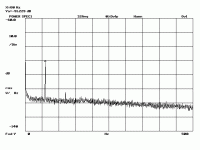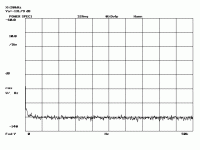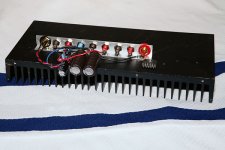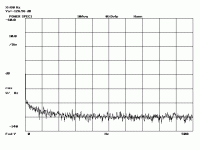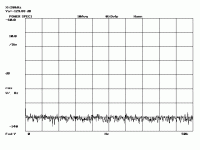Folks,
As I seem to have hi-jacked the "Comparing LME49810, LME49811, LME49830 thread" with my grounding issues, I have started a new thread.
The post below seems to be a good starting point for this.
---
So as promised, here are the noise plots (in dBV/rt(Hz)) for an LM3886 amp with a gain of 20 V/V (26 dB). When building the amp, I made sure to have proper star grounding.
I am fairly certain that the remaining 60 Hz hum is electrostatic coupling into the input and/or feedback. I suppose I could shield the circuit with some aluminum foil to find out for sure, but I haven't bothered.
Initially, I had issues with multiple harmonics of 60 Hz showing up on the output. I got rid of those by grounding the heat sink the LM3886 is mounted to. I'm using the TF version (isolated package).
There's still a very, very faint hiss in the speaker. But the hum is gone. The hiss is only audible when I put my ear 1-2 cm from the tweeter dome so I can live with it.
Bottom line: Star ground does matter.
~Tom
As I seem to have hi-jacked the "Comparing LME49810, LME49811, LME49830 thread" with my grounding issues, I have started a new thread.
The post below seems to be a good starting point for this.
---
So as promised, here are the noise plots (in dBV/rt(Hz)) for an LM3886 amp with a gain of 20 V/V (26 dB). When building the amp, I made sure to have proper star grounding.
I am fairly certain that the remaining 60 Hz hum is electrostatic coupling into the input and/or feedback. I suppose I could shield the circuit with some aluminum foil to find out for sure, but I haven't bothered.
Initially, I had issues with multiple harmonics of 60 Hz showing up on the output. I got rid of those by grounding the heat sink the LM3886 is mounted to. I'm using the TF version (isolated package).
There's still a very, very faint hiss in the speaker. But the hum is gone. The hiss is only audible when I put my ear 1-2 cm from the tweeter dome so I can live with it.
Bottom line: Star ground does matter.
~Tom
Attachments
Latest update: As I broke down the setup following my post, I discovered that the output of the amp wasn't connected to the load but rather to a distortion analyzer that was turned off. If I connect the amp to the load, I get more harmonics of the 60 Hz.
My load resistor is set up on a rather large aluminum heat sink with fans. I wonder if it is acting as an antenna. I'll need to figure this one out...
I now have two channels working. I don't hear any hum in the speakers just a very, very faint hiss when I press my ear against the speaker. I got it done late last night so I haven't spent a lot of time listening to it, but my initial impression is good.
~Tom
My load resistor is set up on a rather large aluminum heat sink with fans. I wonder if it is acting as an antenna. I'll need to figure this one out...
I now have two channels working. I don't hear any hum in the speakers just a very, very faint hiss when I press my ear against the speaker. I got it done late last night so I haven't spent a lot of time listening to it, but my initial impression is good.
~Tom
You must be aware of the power supply rejection ratio. How much is the hum related to the output really? -90 dBV = 30 uV
Every amp has a noise and your result is very good.
I know. But the engineer in me can't help being curious as to where the little bit of hum that is left is injected.
~Tom
Bingo!
I got it figured out. The 60 Hz "spur" was indeed caused by electrostatic coupling into the circuit. I wrapped the circuit in aluminum foil (after insulating it with a plastic bag) and measured the noise again. All ripple components are now gone.
Interestingly, grounding the load resistor heat sink knocked 6 dB off the 60 Hz spur. That was definitely an unexpected result.
Figures below show the output noise voltage (dBV/rt(Hz)) with the amp input grounded with a 50 Ohm terminator. The amp gain is 20.6 V/V (26.3 dB). The noise floor measures approx -130 dBV/rt(Hz), corresponding to 316 nV/rt(Hz) - or an input referred noise voltage spectral density of 15.3 nV/rt(Hz). Quite nice!
~Tom
I got it figured out. The 60 Hz "spur" was indeed caused by electrostatic coupling into the circuit. I wrapped the circuit in aluminum foil (after insulating it with a plastic bag) and measured the noise again. All ripple components are now gone.
Interestingly, grounding the load resistor heat sink knocked 6 dB off the 60 Hz spur. That was definitely an unexpected result.
Figures below show the output noise voltage (dBV/rt(Hz)) with the amp input grounded with a 50 Ohm terminator. The amp gain is 20.6 V/V (26.3 dB). The noise floor measures approx -130 dBV/rt(Hz), corresponding to 316 nV/rt(Hz) - or an input referred noise voltage spectral density of 15.3 nV/rt(Hz). Quite nice!
~Tom
Attachments
For the noise measurements, I use an HP 3562A dynamic signal analyzer. For the distortion, an HP 8903A audio analyzer.
I control the instruments via a Prologix USB-GPIB controller using KE5FX's GPIB toolkit to get the plots from the 3562A. And I use a MATLAB script that I've developed to make the distortion curves. Eventually, those scripts will make it on to my Audio Website that I'm in the process of setting up.
~Tom
I control the instruments via a Prologix USB-GPIB controller using KE5FX's GPIB toolkit to get the plots from the 3562A. And I use a MATLAB script that I've developed to make the distortion curves. Eventually, those scripts will make it on to my Audio Website that I'm in the process of setting up.
~Tom
I find the 8903A to be easier and more flexible in day-to-day use. Its built-in source has extremely low distortion. It's nice to have a distortion number readout so one can tweak the circuit to achieve minimum distortion (bias adjust for example). Its AC voltmeter is nice and makes conversion from voltage to power into 8 ohms a snap (just enter: 19.0 SPCL).
But if I want to measure the noise floor or figure out which harmonic is the dominant contributor to the THD, I use the 3562A. It's also useful for IMD measurements or to figure out how much 60/120 Hz ripple makes it through the amp. It's a nice, does-it-all box but the much underappreciated HP 3581A Wave Analyzer is a realistic substitute if you know the frequency of the signal of interest.
~Tom
But if I want to measure the noise floor or figure out which harmonic is the dominant contributor to the THD, I use the 3562A. It's also useful for IMD measurements or to figure out how much 60/120 Hz ripple makes it through the amp. It's a nice, does-it-all box but the much underappreciated HP 3581A Wave Analyzer is a realistic substitute if you know the frequency of the signal of interest.
~Tom
120 Hz should dominate you should see it above noise floor esp at load! from the 60 Hz reading being highest means you have a measurement ground loop. on the DUT yank the chassis to earth to check or better yet connect it to the SA chassis with a piece of braid or Cu tape. Something is not right if adding shielding chages the noise reading.
I use a big aluminum plate sitting on the bench connecting the DUT (PS +amp +load) and SA together.
I use a big aluminum plate sitting on the bench connecting the DUT (PS +amp +load) and SA together.
Last edited:
I got the hum issues sorted out. The 60 Hz I was seeing was due to EMI pick-up. When I shielded the amp in grounded aluminum foil, the last bit of 60 Hz went away.
Another potential source of 60 Hz hum is a defective rectifier.
120 Hz on the other hand is always ripple. Of course, those in countries where 50 Hz mains are used, substitute 50/100 Hz for 60/120 Hz above.
~Tom
Another potential source of 60 Hz hum is a defective rectifier.
120 Hz on the other hand is always ripple. Of course, those in countries where 50 Hz mains are used, substitute 50/100 Hz for 60/120 Hz above.
~Tom
- Status
- This old topic is closed. If you want to reopen this topic, contact a moderator using the "Report Post" button.
- Home
- Amplifiers
- Chip Amps
- LME49810/11/30, LM3886 hum issues & grounding
